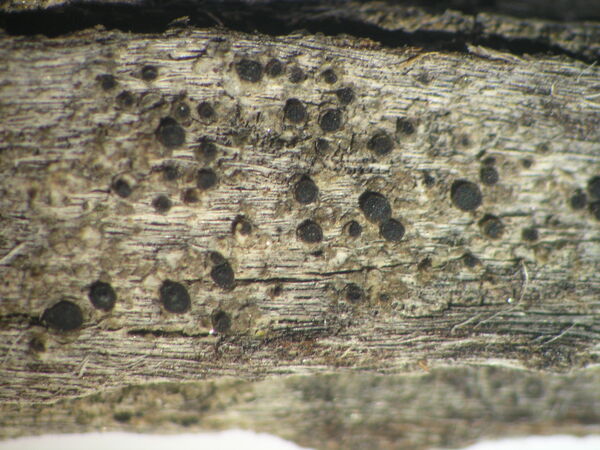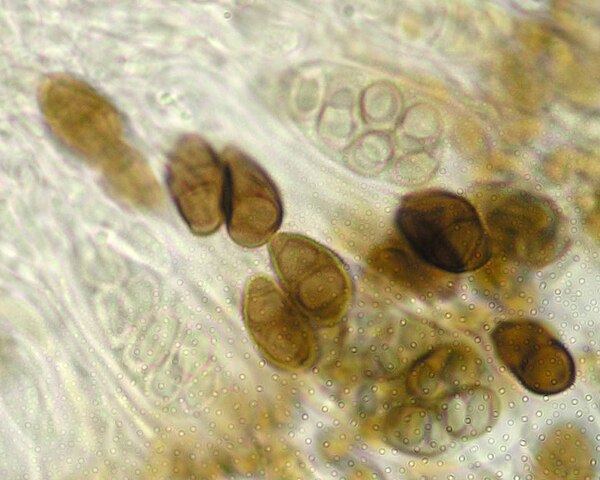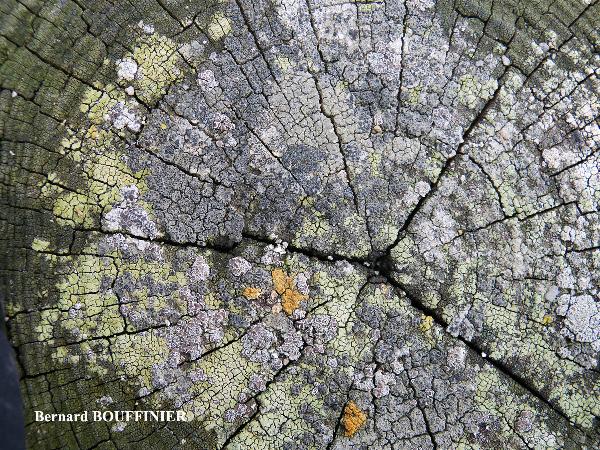Rinodina oleae Bagl.
Mem. R. Accad. Sci. Torino, ser. 2, 17: 403, 1857.
Synonyms: Rinodina exigua var. glauca H. Magn.
Distribution: N - Emil (Nascimbene & al. 2021), Lig (Anzi Lich. Lang. 304 and E.C.I. 35: Giralt & Mayrhofer 1995). C - Tosc (Jatta 1909-1911), Sar (Giralt & Mayrhofer 1995). S - Camp (Aprile & al. 2003b), Pugl (Giralt & Mayrhofer 1995, Nimis & Tretiach 1999), Cal (Giralt & Mayrhofer 1995), Si (TSB 21495).
Description: Thallus crustose, thinly episubstratic, continuous to rimose-areolate, sometimes reduced to a few small areoles around the apothecia but usually forming larger patches, whitish grey to pale greenish grey, dull, with or without an evident dark prothallus. Apothecia lecanorine or cryptolecanorine, immersed to adnate, 0.2-0.5(-0.7) mm across, with a dark brown to black, epruinose, flat to slightly convex disc, an entire, thin, finally often excluded thalline margin, and a more or less evident parathecial ring. Thalline exciple absent or 50-60 µm wide, ecorticate or with a 10-25(-40) µm thick cortex reacting I+ faintly blue, without crystals; proper exciple thin; epithecium dark brown, K-; hymenium colourless, not inspersed with oil droplets, 60-90 µm high, K/I+ blue; paraphyses 1.5-2.5 µm thick at mid-level, not strongly coherent, the apical cells 3-5(-6) µm wide; hypothecium colourless, (30-)50-80 µm high. Asci 8-spored, narrowly clavate to clavate, the K/I+ blue tholus penetrated by a faintly amyloid apical cushion with parallel or diverging flanks, the wall K/I-, surrounded by a K/I+ blue outer layer, Lecanora-type. Ascospores 1-septate, pigmented, broadly ellipsoid, sometimes slightly curved, (11-)15-17(-21) x (6-)7-8(-9.5) µm, Dirinaria-type, with a warted wall, swollen around the septum after pre-treatment with K, the torus absent or poorly developed, the ontogeny of type B (apical thickenings visible before the insertion of the septum). Pycnidia immersed, black, pyriform. Conidia bacilliform, 3-4(-5) x c. 1 µm. Photobiont chlorococcoid. Spot tests: cortex and medulla K-, C-, KC-, P-, UV-. Chemistry: without lichen substances.
Note: a mainly coastal, Mediterranean epiphytic lichen which was overlooked or confused with similar species in the past; mostly Tyrrhenian in Italy. The species is very closely related to the saxicolous R. gennarii (see comment on that species).
Growth form: Crustose
Substrata: bark
Photobiont: green algae other than Trentepohlia
Reproductive strategy: mainly sexual
Taxon bound to maritime-coastal situations
Commonnes-rarity: (info)
Alpine belt: absent
Subalpine belt: absent
Oromediterranean belt: absent
Montane belt: absent
Submediterranean belt: extremely rare
Padanian area: absent
Humid submediterranean belt: absent
Humid mediterranean belt: rare
Dry mediterranean belt: very rare
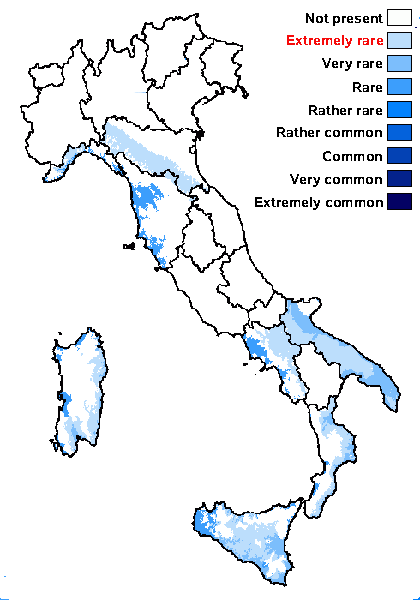
Predictive model
Herbarium samples
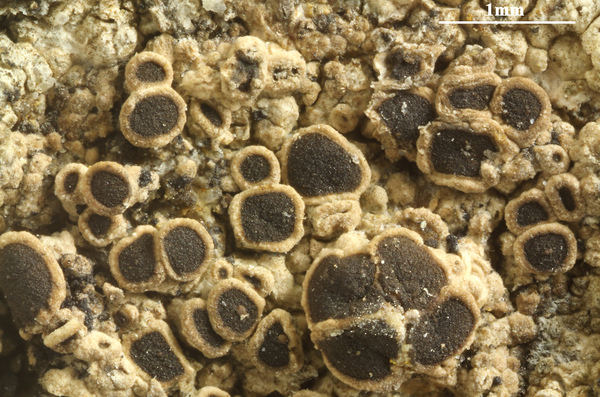

Felix Schumm - CC BY-SA4.0
[20874], Ireland, County Clare (Contae an Cláir), 2.2 km NW of the centre of Doonbeg. 'White Strand Doobeg', souther bound, 52°44'47'' N, 9°32'56'' W, 2 m, coastal rocks, on schist. Leg. H. Mayrhofer (no 21840), 17.07.2012, det. H. Mayrhofer. LICHENOTHECA GRAECENSIS NO. 495
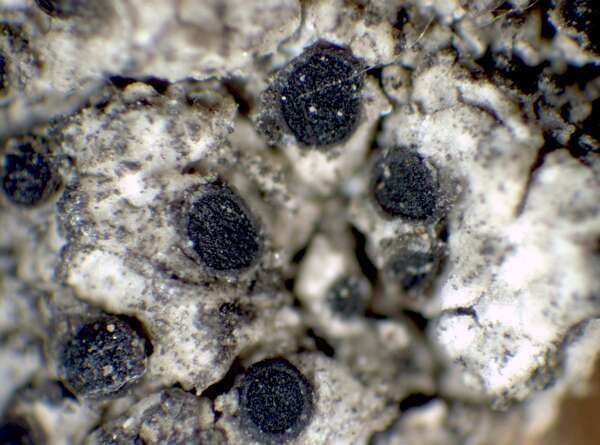

P.L. Nimis; Owner: Department of Life Sciences, University of Trieste
Herbarium: TSB (6148)
2001/11/29


Felix Schumm - CC BY-SA4.0
[20874], Ireland, County Clare (Contae an Cláir), 2.2 km NW of the centre of Doonbeg. 'White Strand Doobeg', souther bound, 52°44'47'' N, 9°32'56'' W, 2 m, coastal rocks, on schist. Leg. H. Mayrhofer (no 21840), 17.07.2012, det. H. Mayrhofer. LICHENOTHECA GRAECENSIS NO. 495
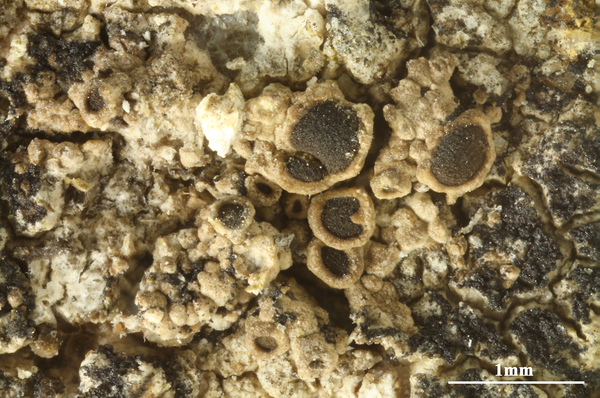

Felix Schumm - CC BY-SA4.0
[20874], Ireland, County Clare (Contae an Cláir), 2.2 km NW of the centre of Doonbeg. 'White Strand Doobeg', souther bound, 52°44'47'' N, 9°32'56'' W, 2 m, coastal rocks, on schist. Leg. H. Mayrhofer (no 21840), 17.07.2012, det. H. Mayrhofer. LICHENOTHECA GRAECENSIS NO. 495
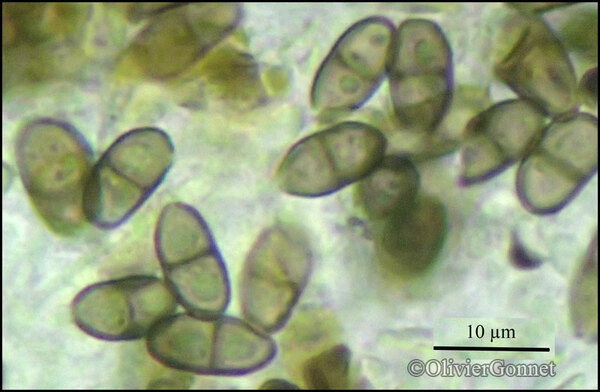
Courtesy Danièle et Olivier Gonnet - Source: https://www.afl-lichenologie.fr/Photos_AFL/Photos_AFL_R/Textes_R/Rinodina_oleae.htm
France, 2/9/2014 - Pont de L'Oulietta, 2500 m - Bonneval-sur-Arc - Savoie
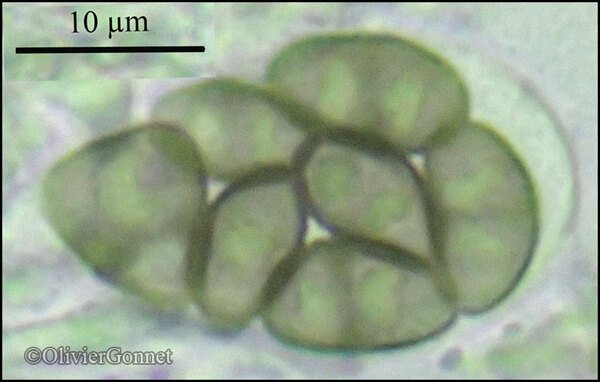
Courtesy Danièle et Olivier Gonnet - Source: https://www.afl-lichenologie.fr/Photos_AFL/Photos_AFL_R/Textes_R/Rinodina_oleae.htm
France, 2/9/2014 - Pont de L'Oulietta, 2500 m - Bonneval-sur-Arc - Savoie
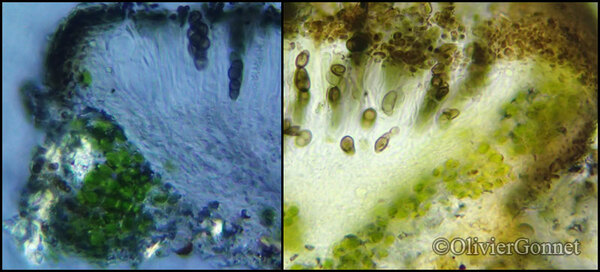
Courtesy Danièle et Olivier Gonnet - Source: https://www.afl-lichenologie.fr/Photos_AFL/Photos_AFL_R/Textes_R/Rinodina_oleae.htm
France, 2/9/2014 - Pont de L'Oulietta, 2500 m - Bonneval-sur-Arc - Savoie

Courtesy Danièle et Olivier Gonnet - Source: https://www.afl-lichenologie.fr/Photos_AFL/Photos_AFL_R/Textes_R/Rinodina_oleae.htm
France, 2/9/2014 - Pont de L'Oulietta, 2500 m - Bonneval-sur-Arc - Savoie
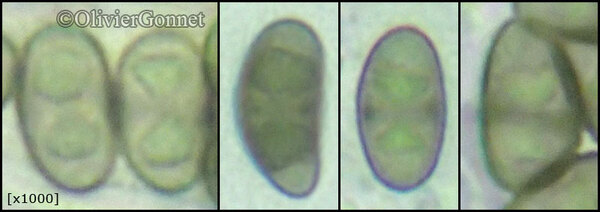
Courtesy Danièle et Olivier Gonnet - Source: https://www.afl-lichenologie.fr/Photos_AFL/Photos_AFL_R/Textes_R/Rinodina_oleae.htm
France, 2/9/2014 - Pont de L'Oulietta, 2500 m - Bonneval-sur-Arc - Savoie

Bernard Bouffinier - Source: http://www.lichensmaritimes.org/index.php?task=fiche&lichen=1467&lang=en
France, Douarnenez
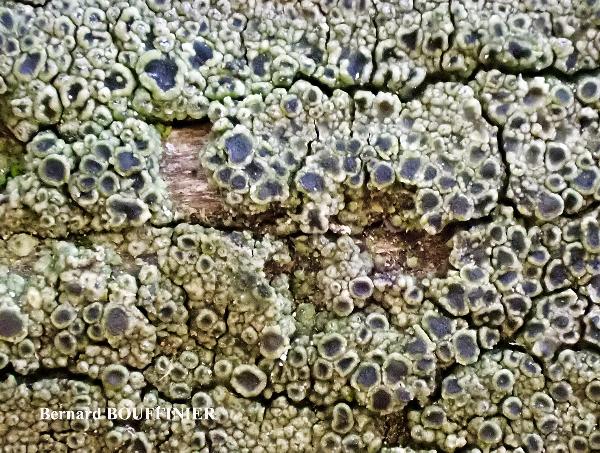
Bernard Bouffinier - Source: http://www.lichensmaritimes.org/index.php?task=fiche&lichen=1467&lang=en
France, Douarnenez

Bernard Bouffinier - Source: http://www.lichensmaritimes.org/index.php?task=fiche&lichen=1467&lang=en
France, Douarnenez
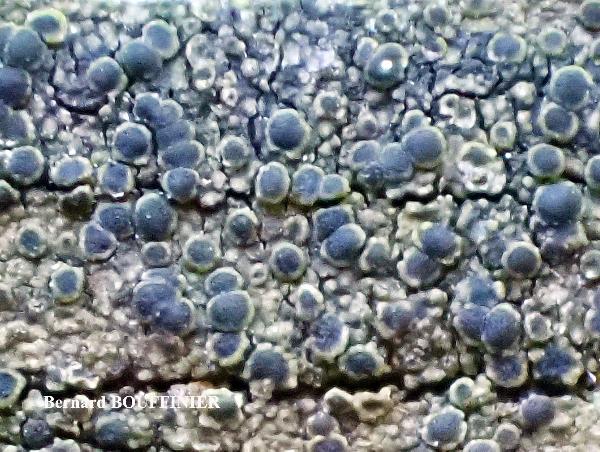
Bernard Bouffinier - Source: http://www.lichensmaritimes.org/index.php?task=fiche&lichen=1467&lang=en
France, Douarnenez
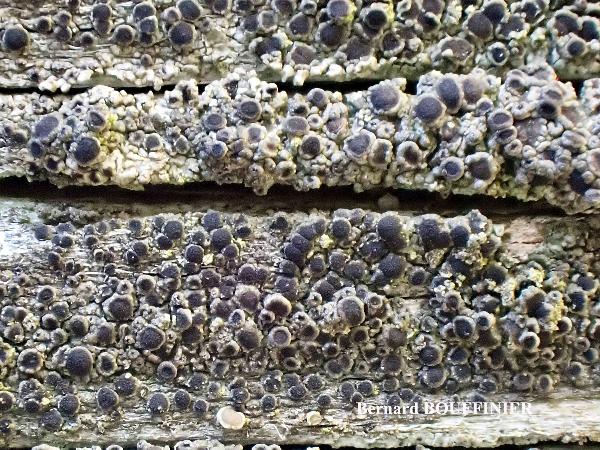
Bernard Bouffinier - Source: http://www.lichensmaritimes.org/index.php?task=fiche&lichen=1467&lang=en
France, Kersiguenou
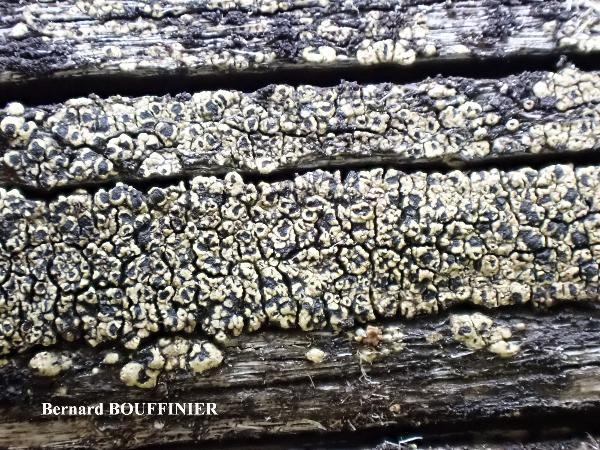
Bernard Bouffinier - Source: http://www.lichensmaritimes.org/index.php?task=fiche&lichen=1467&lang=en
France, Quimper
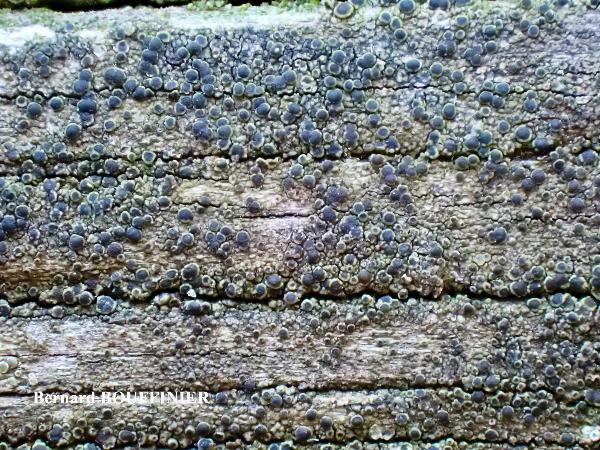
Bernard Bouffinier - Source: http://www.lichensmaritimes.org/index.php?task=fiche&lichen=1467&lang=en
France, Douarnenez
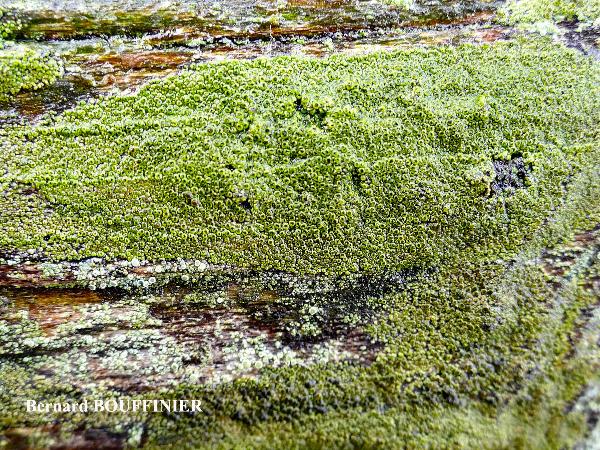
Bernard Bouffinier - Source: http://www.lichensmaritimes.org/index.php?task=fiche&lichen=1467&lang=en
France, Douarnenez
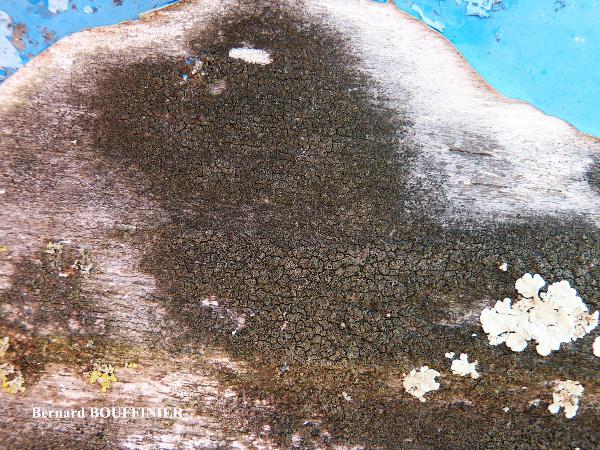
Bernard Bouffinier - Source: http://www.lichensmaritimes.org/index.php?task=fiche&lichen=1467&lang=en
France, Rostellec

Bernard Bouffinier - Source: http://www.lichensmaritimes.org/index.php?task=fiche&lichen=1467&lang=en
France, Rostellec
Growth form: Crustose
Substrata: bark
Photobiont: green algae other than Trentepohlia
Reproductive strategy: mainly sexual
Taxon bound to maritime-coastal situations
Commonnes-rarity: (info)
Alpine belt: absent
Subalpine belt: absent
Oromediterranean belt: absent
Montane belt: absent
Submediterranean belt: extremely rare
Padanian area: absent
Humid submediterranean belt: absent
Humid mediterranean belt: rare
Dry mediterranean belt: very rare

Predictive model
| Herbarium samples |


Felix Schumm - CC BY-SA4.0
[20874], Ireland, County Clare (Contae an Cláir), 2.2 km NW of the centre of Doonbeg. 'White Strand Doobeg', souther bound, 52°44'47'' N, 9°32'56'' W, 2 m, coastal rocks, on schist. Leg. H. Mayrhofer (no 21840), 17.07.2012, det. H. Mayrhofer. LICHENOTHECA GRAECENSIS NO. 495


P.L. Nimis; Owner: Department of Life Sciences, University of Trieste
Herbarium: TSB (6148)
2001/11/29


Felix Schumm - CC BY-SA4.0
[20874], Ireland, County Clare (Contae an Cláir), 2.2 km NW of the centre of Doonbeg. 'White Strand Doobeg', souther bound, 52°44'47'' N, 9°32'56'' W, 2 m, coastal rocks, on schist. Leg. H. Mayrhofer (no 21840), 17.07.2012, det. H. Mayrhofer. LICHENOTHECA GRAECENSIS NO. 495


Felix Schumm - CC BY-SA4.0
[20874], Ireland, County Clare (Contae an Cláir), 2.2 km NW of the centre of Doonbeg. 'White Strand Doobeg', souther bound, 52°44'47'' N, 9°32'56'' W, 2 m, coastal rocks, on schist. Leg. H. Mayrhofer (no 21840), 17.07.2012, det. H. Mayrhofer. LICHENOTHECA GRAECENSIS NO. 495

Courtesy Danièle et Olivier Gonnet - Source: https://www.afl-lichenologie.fr/Photos_AFL/Photos_AFL_R/Textes_R/Rinodina_oleae.htm
France, 2/9/2014 - Pont de L'Oulietta, 2500 m - Bonneval-sur-Arc - Savoie

Courtesy Danièle et Olivier Gonnet - Source: https://www.afl-lichenologie.fr/Photos_AFL/Photos_AFL_R/Textes_R/Rinodina_oleae.htm
France, 2/9/2014 - Pont de L'Oulietta, 2500 m - Bonneval-sur-Arc - Savoie

Courtesy Danièle et Olivier Gonnet - Source: https://www.afl-lichenologie.fr/Photos_AFL/Photos_AFL_R/Textes_R/Rinodina_oleae.htm
France, 2/9/2014 - Pont de L'Oulietta, 2500 m - Bonneval-sur-Arc - Savoie

Courtesy Danièle et Olivier Gonnet - Source: https://www.afl-lichenologie.fr/Photos_AFL/Photos_AFL_R/Textes_R/Rinodina_oleae.htm
France, 2/9/2014 - Pont de L'Oulietta, 2500 m - Bonneval-sur-Arc - Savoie

Courtesy Danièle et Olivier Gonnet - Source: https://www.afl-lichenologie.fr/Photos_AFL/Photos_AFL_R/Textes_R/Rinodina_oleae.htm
France, 2/9/2014 - Pont de L'Oulietta, 2500 m - Bonneval-sur-Arc - Savoie

Bernard Bouffinier - Source: http://www.lichensmaritimes.org/index.php?task=fiche&lichen=1467&lang=en
France, Douarnenez

Bernard Bouffinier - Source: http://www.lichensmaritimes.org/index.php?task=fiche&lichen=1467&lang=en
France, Douarnenez

Bernard Bouffinier - Source: http://www.lichensmaritimes.org/index.php?task=fiche&lichen=1467&lang=en
France, Douarnenez

Bernard Bouffinier - Source: http://www.lichensmaritimes.org/index.php?task=fiche&lichen=1467&lang=en
France, Douarnenez

Bernard Bouffinier - Source: http://www.lichensmaritimes.org/index.php?task=fiche&lichen=1467&lang=en
France, Kersiguenou

Bernard Bouffinier - Source: http://www.lichensmaritimes.org/index.php?task=fiche&lichen=1467&lang=en
France, Quimper

Bernard Bouffinier - Source: http://www.lichensmaritimes.org/index.php?task=fiche&lichen=1467&lang=en
France, Douarnenez

Bernard Bouffinier - Source: http://www.lichensmaritimes.org/index.php?task=fiche&lichen=1467&lang=en
France, Douarnenez

Bernard Bouffinier - Source: http://www.lichensmaritimes.org/index.php?task=fiche&lichen=1467&lang=en
France, Rostellec

 INDEX FUNGORUM
INDEX FUNGORUM
 GBIF
GBIF
 DOLICHENS
DOLICHENS
